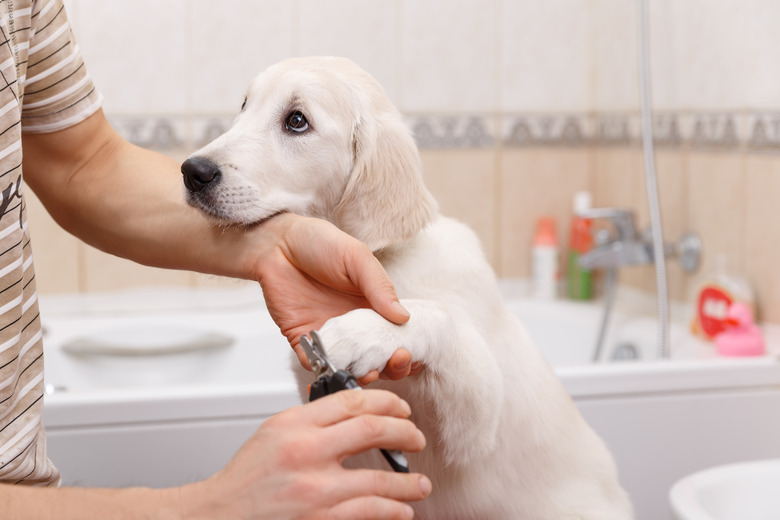How To Cut An Overgrown Dew Claw
As with the fingernails of humans, dogs' nails are constantly growing. To keep a dog from slipping on a floor or getting their claws stuck in cloth, the nails must undergo regular trimming. Most dogs have vestigial thumb toes higher up on their legs with a claw, known as the dew claw. Cutting dew claws can be challenging.
Since dew claws do not come in contact with the ground, they do not experience the wear of other claws and can easily grow too long — irritating or embedding in the leg tissue, or getting caught on obstacles in the dog's environment.
Dogs with rear dewclaws will have the extra claw on the inside of their leg. It can look like a full toe, or a loose piece of skin with a claw attached. Following is a how-to for dew claw trimming.
1. Restrain the dog
Restrain the dog with your body before clipping any nails, unless the dog willingly sits and waits for its nails to be clipped. This is done by setting the dog on a table and covering the animal with your upper body so that your clipping, or dominant, arm reaches over the dog's body to the paw on the other side.
Meanwhile, your non-dominant forearm should sit over the dog's neck to prevent it from raising its head, and to hold the paw. If the dog squirms too much, try laying it on its side so that your body passes over the dog in the same way to hold it down, with the paws facing away from you.
2. Look for the quick
Hold the dew claw away from the leg enough to clip easily. If the claw is dark-colored, the "quick" inside the claw is not visible and the trimming must be done in several very small clips. The quick is a center of nerves and blood vessels and can cause the dog pain if clipped.
On a light claw, the discoloration of the quick is visible, but on a claw where this center is not visible, take small clips until the end of the claw shows a gray or pink oblong area instead of the separated nail and under-nail tissue colors. Stop at this point to avoid cutting the quick. To help find the nail quick, there are clippers that include a quick finder available at most pet retailers.
3. Use a dog nail grinder
File the end of the claw to remove sharp irregularities. This step is important because a ragged or sharp nail can cause problems for the dog, human companions, and other pets.
A sharp nail could get caught on something. Dirt, grass, or carpet fibers could get embedded in the ragged area. A dog could accidentally scratch another pet or a human, which would end up causing more injury than a manicured nail.
A dog nail grinder, also known as a Dremel, is the perfect tool to use for filing your pooch's claws. You'll probably have so much ease using this tool, it will be your go-to for future nail trims. To find the right product for your pup, do some research on the best dog nail clippers or ask your veterinarian for recommendations.
4. Clip in small increments
Remove small amounts of nail on greatly overgrown dew claws since the quick expands on overgrown claws. With regular trimming, the quick will recede and allow the nail to remain clipped short.
5. Removing the dew claw
It is sometimes necessary to remove the dew claw entirely, with its skin attachment, or toe. This option may make sense for an overgrown claw that is infected or that often gets stuck on objects in the dog's environment, and is an operation that a veterinarian must perform.
Things Needed
-
Restrain such as a grooming leash and collar
-
Nail quick finder
-
Nail grinder or Dremel
-
Scissor-style dog nail clippers
-
Nail file
